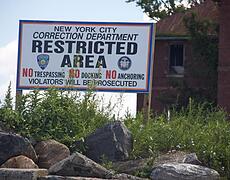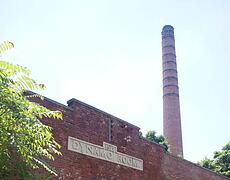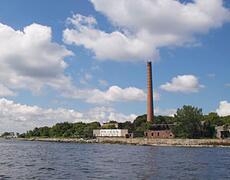
As some of you know, I made a guerrilla landing on Hart Island, the largest burial ground in the world, while researching our novel GIDEON'S SWORD. By the way, Linc has asked me to make clear that HE DID NOT TAKE PART IN THIS IDIOTIC AND DANGEROUS EXPEDITION. --Doug
While researching Hart Island, I came across a strange piece of information. There is something else buried on Hart Island, something a lot creepier than mere corpses. When we came across this strange and startling fact, it immediately gave us the central idea for our thriller novel, Gideon’s Sword. I wish I could tell you what is buried on Hart Island, but to do so would completely ruin the novel.
When we embarked on writing Gideon’s Sword, we decided to set the final, exciting chase scenes on Hart Island. Linc and I pride ourselves on the verisimilitude of our settings. And this deserted island might just be the most haunted place in all of New York. In addition to being the largest burial ground in the world, Hart Island was once a quarantine for sailors with yellow fever; a tubercularium; a Nike missile base; a boy’s workhouse; and an insane asylum for women. Now the hundred-acre island is completely uninhabited, dotted with buildings falling into ruin. It made for an extraordinary setting for our novel, with its vast graveyards, decaying missile silos, dormitories preserving the sad and desperate graffiti of boys without hope, an old chapel, and (of all things) an abandoned baseball diamond whose rotting bleachers came from Ebbets Field.
To research the setting for Gideon’s Sword, I tried to get permission to visit the island. Permission was denied. The island is completely and absolutely off limits to everyone but dead people, prisoners, and guards. If I wanted to see the island, there was only one way: to make a guerilla landing.
I asked my writing partner Linc if he wanted to come. He informed me that he would have nothing to do with the scheme, advised me to abandon it, and when I persisted he declared his hope that I would rot in prison.
So I enlisted my wife Christine, who is a professional photographer, as my partner in crime.
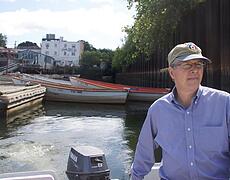
Leaving Jack's Bait and Tackle on City Island, the Bronx, heading out into Long Island Sound for our Guerilla landing on Hart Island.
Jack saw us down to the boat. “Stick around, don’t go far, and stay out of the open Sound. And whatever you do, don’t land on any islands.”
We assured him we wouldn’t.
I fired up the old Evinrude and we set off at a top speed of two knots, passing under the City Island bridge. It was a splendid day, the sun glittering off the water, a breeze kicking up a bit of chop. As we rounded High Island, I steered the scow through the channel south of the Chimney Sweeps and out into the Sound.
Hart Island rose into view.
It is a sinister island—low, grim, covered with scrubby trees. Rising above the unnaturally healthy vegetation are extensive, massive ruins of a picturesque nature. Even from half a mile away we could see large signs posted along the shore every few hundred yards:
NEW YORK CITY
CORRECTION DEPARTMENT
RESTRICTED
AREA
NO TRESPASSING NO DOCKING NO ANCHORING
VIOLATORS WILL BE PROSECUTED
“I don’t think they have enough signs,” Christine said.
We circled the island, looking for a hidden place to land. The island was almost completely surrounded by vicious reefs and rocky, shoaling water. Along the shoreline were strewn a number of wrecked boats and derelict hulls.
The only safe landing area was where the island’s pier was located, but we could not land there and expect to escape detection.
As we came around the eastern side of the island, a long cobbled beach came into view, bounded by a low sea wall. Behind it rose the fantastical ruins of an ancient brick edifice, built in Romanesque Revival style, dominated by a vast chimney, twenty stories high. Painted on the brick façade facing the sea was an emphatic message, perhaps a hundred feet wide and twenty tall:
P R I S O N
K E E P O F F
A row of seaweed-covered rocks rose like stubby teeth from the water between us and the beach.
“We’ll land there,” I said.
“Are you sure that’s a good idea?” Christine asked.
“No.”
With Christine in the bow peering into the murky water, and my constant checking of the chart, we wormed our way through the reefs to shore. We landed below the sea wall in a hidden section of the strand not visible from above. The boat was too heavy to drag up the beach, so I fixed the anchor around a big rock above the high-tide mark.
We crept up to the sea wall and peered over. Ahead of us stretched a large weedy field, dominated by an elegant stucco house in an advanced state of decrepitude. On the far side of the field stood a modest suburban neighborhood of streets, houses, and sidewalks, utterly in ruin, the houses staring post-apocalyptically, the sidewalks splitting and weed-grown, the former lawns choked with poison sumac.
To our left rose the extensive Romanesque ruins dominated by the towering stack, which was cracked and crumbling and looked like it might fall down at any moment.
Nobody was in sight.
We rose from our hiding place and made our way across the meadow to the warden’s house. Christine started taking pictures as I poked around, taking notes. Leaving the house behind, we crept through the brush to the Romanesque pile. A carved marble lintel announced its function:
1912
DYNAMO ROOM
Inside we could see the moldering remains of gargantuan machines. This, clearly, had once been the island’s power plant. We ventured inside. The roof had caved in, allowing vines and trees to grow up in between the machines, their roots penetrating the rotten wood floor. Every slight motion of wind caused the disintegrating ceiling with its hanging beams and rafters to shift and creak.
“This doesn’t look safe,” I said.
We strolled out to the overgrown road in front. All seemed quiet. The island felt deserted. But as we began to walk north, toward the mass burial grounds, Christine paused.
“Do you hear that?”
I listened. It was a grinding noise.
“That sound’s on the island!”
Caught out in the open, we sprinted toward a vacant building across a meadow. Just before rounding the corner I got a glimpse of a ramshackle bus creeping along the road, followed by a backhoe belching soot.
We leapt through a busted out window and crouched behind a riot of plant growth.
“They didn’t see us,” I said. “I’m sure of it.” My heart was hammering like a rat in a tin can.
But then we heard shouts. I peeked through the weeds and saw a pumped-up corrections officer running through the weeds, his Glock drawn. There were shouts, cries, and distant catcalls. I could hear someone yelling, “Stay on the bus! Don’t get off the bus!” As I peered out I could see the bus has stopped—a bus packed with Riker’s Island prisoners in orange jumpsuits, all crowding forward, hanging out the windows, yelling and gesturing. Three guards had gotten off the bus. Two were looking for us while the third stood guard.
“Stay on the fucking bus!”
I looked at Christine. “Better we surrender now than wait for them to find us.”
“Yeah.”
The guard had already passed our hiding place, so Christine and I climbed out of the window, pushed through the weeds, and strolled out into the open, hands in our pockets, looking innocent.
“There they are!” screamed the distant guard, brandishing his weapon.
The pumped up fellow came racing back. “Keep your hands in sight!” he yelled, approaching us at a crouch. “Identify yourselves!” He was all out of countenance.
“We’re just tourists!” I cried. “We didn’t do anything!”
“Tourists?” He squinted at us, rose, holstered his weapon.
“From New Mexico! Tourists from New Mexico!” And in a flash I had my wallet out, waving my New Mexico driver’s license. He took it, squinted at it, stared at my wife. “And your ID, lady?”
“Um, I didn’t bring it,” said Christine. “He’s my husband.”
“Husband.”
In the background: “Siddown motherfuckers keep your fucking heads inside the fucking bus.”
“What are you doing here?”
I went into a long, rambling, semi-incoherent story about how we were tourists from New Mexico, visiting New York for the first time, and we had rented a boat in City Island to go fishing but, since the fishing was no good, had decided to land on the island, as my wife was particularly interested in ruins. We had a lot of Indian ruins in New Mexico.
He cut me off. “Didn’t you see the signs?”
“Signs?” I assumed a slack-jawed, hick-tourist-visiting-the-Big-Apple expression.
He was getting mad now. “The signs! Jesus Christ, the big signs that are everywhere along the shore!”
“I did see a sign that said PRISON KEEP OFF but it looked so old and the building it was on was in ruins, I figured it wasn’t a prison any more. Are there prisoners here?”
He ignored the question. “You didn’t see the other signs?”
“No.”
He looked at Christine with narrowed eyes. “What are you doing with that camera?”
“Taking pictures.”
“What for?”
“Isn’t that what tourists do, like, take pictures?”
“You can’t take pictures here. It’s against the law.”
“I’m sorry,” said Christine. Then she asked, maliciously, “What’s this island all about, anyway? What are you all doing?”
“Landscaping,” came the gruff reply, after a pause. He shifted his gaze to me, stared hard, then slipped out his cell phone. Keeping his eyes fixed on me, he spoke. “Got some tourists from New Mexico here, landed on the island in a boat, been taking pictures. What should I do?”
He listened for a while and handed the phone to me. “The supervisor wants to talk to you.”
I took the phone. “Hello?”
A cheerful, avuncular voice greeted me. “I’m terribly sorry, but I’m afraid we’re going to have to arrest you.”
“Oh,” I said. “Really?”
“Yes, really.”
“But we’re just tourists from New Mexico.”
“So I heard.” A long silence. Then: “Put the officer back on the phone, please.”
He took it, listened a while, hung up. “He wants to come down and talk to you.”
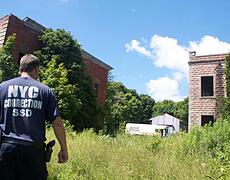
Christine's surreptitious picture of the prison guard who caught us, escorting us to his superior. The bus in the background is full of Rikers Island inmates brought to Hart Island to bury bodies.
“What? Burying dead people?” I pretended to be surprised.
“That’s right,” he said with a touch of pride. “We got a million dead people interred on this island. Biggest graveyard in the world. This here is the Potter’s Field for New York City. You didn’t know that?”
We both made suitable expressions of astonishment and wonder.
I asked if he knew much about the history of the island. That got him going. He knew the entire history of the island from the time it was a prisoner of war camp for Confederate soldiers up to the present day. We were both genuinely interested and we showed it. We heard about the yellow fever epidemics, the insane asylum, the missile base, Ebbets Field and the inextinguishable tragedy of the old Brooklyn Dodgers. I was itching to take notes but figured it wouldn’t look good.
Finally he turned to Christine. “You got to delete every photograph you took. You do that, maybe I won’t have to arrest you.” He looked around. We now had three or four corrections officers in audience. The inmates had finally been driven off to bury the dead. “Any one here know how to operate a digital camera?”
An officer nodded.
“Go over there and show that gentleman each one of your pictures, one at a time, and then delete it so he can see you deleted it. Every single one.”
Christine went over and, while the officer watched, deleted all her pictures.
“And now I’ll escort you folks to your boat.” We were escorted back to our boat, the captain continuing his history lesson by recounting all the movies and books that had mentioned or featured Hart Island.
He helped Christine into the boat. “All I can say is, you’re lucky folks today. Now you leave this island and have a safe trip back to New Mexico.”
I fired up the engine and we worked our way back out through the reefs into the open Sound. Neither one of us had spoken. I felt sick, thinking of the photographs that Christine had deleted. That had been our major purpose of going to Hart Island, to get photographs I could refer to when writing the novel.
Christine broke the silence. “I didn’t delete a single photograph.”
“Thank God.”
“In fact, I took a few more while I was at it.”
“Excellent,” I said. “Truly excellent.”
My mood was much improved. And now I realized there was one more thing I had to do. I pulled out my cell phone and called Lincoln.
“Um, Linc? You know that trip to Hart Island? Well, I’m here in the Bronx with Christine and they allowed me one phone call, so I immediately thought of you—.”
I was interrupted by an outburst of coarse and vulgar language.
